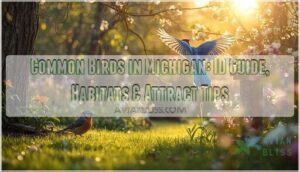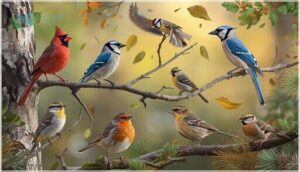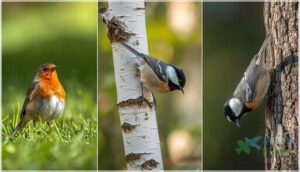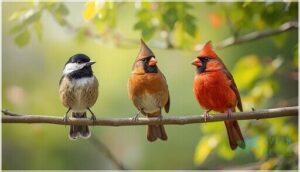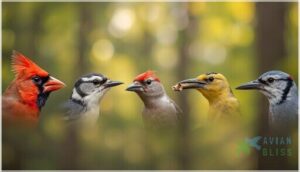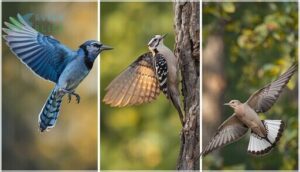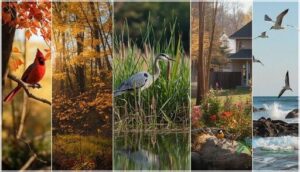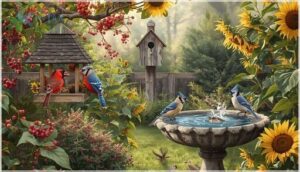This site is supported by our readers. We may earn a commission, at no cost to you, if you purchase through links.
Step out your door in Michigan and the neighborhood sounds shift with the seasons. One morning, an American Robin tips its head and listens for worms in your yard. Another afternoon, a Blue Jay flashes electric blue between the branches, bold as can be. These birds aren’t random visitors—they’re clues to Michigan’s thriving backyard life.
Paying attention to who’s sharing your space can turn any stroll or morning coffee into a discovery. With a bit of practice, you’ll spot familiar faces and pick out common birds in Michigan by the colors, songs, and habits that set them apart.
Table Of Contents
- Key Takeaways
- Most Common Birds in Michigan
- Identifying Michigan Birds by Features
- Birds by Habitat Across Michigan
- Seasonal Bird Visitors in Michigan
- Attracting and Supporting Michigan Birds
- Frequently Asked Questions (FAQs)
- What is the most common bird in Michigan?
- How do I identify a bird in my yard?
- What is the most common backyard bird?
- What is a white-breasted small bird in Michigan?
- What are some common bird species found in Michigan?
- What are some characteristics that can help in identifying common birds in Michigan?
- Where can I find common birds in Michigan?
- What equipment do I need to observe birds in Michigan?
- What is the most common bird of prey in Michigan?
- What do baby birds in Michigan eat?
- Conclusion
Key Takeaways
- Michigan’s most common backyard birds—like American Robins, Northern Cardinals, Blue Jays, and Black-capped Chickadees—are easy to identify once you learn their colors, calls, and behaviors.
- You can tell birds apart by noticing key features like bill shape, wing patterns, distinctive markings (such as a cardinal’s black mask or a nuthatch’s head-down crawl), and how they move or hold their tails.
- Different habitats across Michigan attract different birds—backyard feeders draw chickadees and cardinals, forests shelter woodpeckers, wetlands host waterfowl, and grasslands support declining species like meadowlarks.
- Creating a bird-friendly yard with native plants, clean water sources, and proper feeders not only attracts more species but actively supports their survival through migration, nesting, and harsh Michigan winters.
Most Common Birds in Michigan
If you spend time outside in Michigan, you’ll quickly notice the same friendly faces showing up again and again. These ten birds are the ones you’re most likely to see whether you’re looking out your kitchen window or taking a walk through the park.
Let’s get to know each one so you can spot them with confidence.
American Robin
You’ll spot the American Robin everywhere—Michigan’s state bird since 1931 with its rusty red breast and dark head. This common Michigan bird species thrives in backyards, parks, and wooded areas year-round. Its robin diet includes earthworms, insects, and berries. Migration timing brings most robins back in February and March.
Michigan chose the robin after a statewide contest. Population trends show slight declines recently, but they’re still abundant across the state.
Northern Cardinal
The Northern Cardinal stands out with its bright red plumage and black face mask. This common Michigan bird species is a year-round resident in your backyard.
Cardinal diet includes sunflower seeds, safflower, and insects during breeding habits from March through September. Population trends show steady growth across the state.
Their habitat range covers woodland edges, gardens, and parks. Conservation status remains stable with over 110 million breeding individuals in North America. The species has expanded its range and is considered a permanent Minnesota resident.
Blue Jay
After cardinals, Blue Jays bring a splash of color and bold personality to Michigan birds. Their bright blue feathers and Jay vocalizations make bird identification easy.
You’ll notice their diet adaptability—acorns, seeds, insects—and their knack for seed dispersal helps forest regeneration.
Migration patterns shift each fall, with flocks moving through parks and woods, making Blue Jays common backyard birds.
Black-capped Chickadee
After watching Blue Jays, you’ll often spot the Black-capped Chickadee—one of Michigan’s most common backyard birds. With their bold calls and acrobatic Foraging Behavior, these tiny friends thrive through harsh winters. Stable Population Trends mean you’ll see them year-round. If you want to support Winter Survival, try adding nest boxes and sunflower seeds to your feeder.
- Cheerful calls
- Curious Foraging Behavior
- Cozy Nesting Habits
- Reliable backyard support
American Goldfinch
A splash of yellow in your yard often means an American Goldfinch is nearby. These finch species thrive in weedy fields and gardens, feeding almost entirely on seeds.
Their breeding habits follow late-summer thistle blooms, and their migration patterns shift with food supply. You’ll see steady population trends across Michigan—making them one of the most common Michigan birds to identify.
Downy Woodpecker
If you spot a tiny woodpecker tapping on a tree, chances are it’s a Downy Woodpecker. These year-round birds in Michigan are easy to identify by their short bill and bold black-and-white markings.
Population genetics show their numbers are stable. Their feeding habits favor insects and seeds, while nest cavity choices keep breeding behavior and conservation status healthy.
House Sparrow
House Sparrow—one of Michigan’s most recognizable invasive bird species—thrives in urban and suburban bird populations. You’ll see them at bird feeders, nesting in buildings, and foraging for crumbs. Their dietary flexibility and aggressive native competition help them persist, even as population decline sets in. Here’s what stands out:
- Urban adaptation
- Bold breeding habits
- Population decline
- Dietary flexibility
- Native competition
White-breasted Nuthatch
Ever seen a bird walk headfirst down a tree? That’s classic White-breasted Nuthatch. This friendly little climber favors old forests across Michigan but stops by backyard feeders too.
Its foraging behavior sets it apart—searching bark cracks for insects, then caching seeds for winter. Strong population trends and regional variations point to successful breeding habits, making this species a conservation bright spot.
Tufted Titmouse
Did you know the Tufted Titmouse is a true sign of Range Expansion in Michigan? This bold little bird, with its gray crest and lively calls, thrives in forest ecology and suburban yards alike.
Its Population Growth is tied to feeders and mature trees. Look for its sharp “peter-peter-peter” song—an easy clue for backyard bird identification and bird habitats.
Mourning Dove
Mourning Doves might be the gentle coo you hear every morning—soft as distant thunder. If you’re curious about Dove identification, look for their pale brown bodies and black spots on the wings.
These birds in Michigan thrive statewide, nesting early and often. Their survival rates help keep population trends stable, even with Dove hunting and ever-present predators shaping their story.
Identifying Michigan Birds by Features
Figuring out which bird you’ve spotted in Michigan often comes down to noticing a few key features. Paying attention to things like color, shape, or even the way a bird holds its tail can make a big difference.
Here’s how to spot those details and use them to tell birds apart.
Size and Shape
Size and shape tell you a lot about bird species identification. Look at body proportions, wing shape, tail length, and leg structure for clues. For example, robins stand tall with long legs and medium tails, while chickadees look “big-headed” on tiny bodies.
Posture analysis—like a nuthatch’s head-down crawl—also helps you use bird identification guides with confidence.
Color Patterns
After shape, plumage variations really catch your eye. Bird species in Michigan show all sorts of color patterns—some bright, some subtle. For example:
- Cardinals flash bold red plumage year-round.
- Goldfinches turn yellow in summer, olive in winter (seasonal molting).
- Male and female finches look different (color dimorphism).
- Sparrows blend in thanks to camouflage and regional differences.
Distinctive Markings
Once you catch those vivid colors, you’ll start spotting the real secrets—markings. Notice the Black-capped Chickadee’s crisp cap or a Blue Jay’s black necklace? That’s how your mind starts weaving together Michigan bird species.
Juvenile markings, camouflage strategies, and seasonal changes give each bird a signature look. Check the table for real-life examples:
| Bird | Distinctive Marking | Seasonal Change |
|---|---|---|
| American Robin | White eye arcs, red breast | Duller in winter |
| Northern Cardinal | Black face mask, red crest | No fading |
| Blue Jay | Black throat band, wing bars | Unchanged |
Bill Shape and Size
After spotting those unique markings, your next clue is the bill. Bill morphology isn’t just for show—it’s a key to feeding adaptations and even shapes vocalization impact. For example:
- Cardinals: thick, seed-cracking bills
- Nuthatches: narrow, probing bills
- Woodpeckers: chisel-shaped
- Goldfinches: slender, seed-hulling
- Blue Jays: sturdy, adaptable
Notice these traits for smarter bird identification!
Wing and Tail Characteristics
When you look at a flock, pay close attention to wing and tail details—they often tell the real story. Blue Jays boast bold bands in their plumage, while Downy Woodpeckers’ spotted wings catch sunlight as they climb.
Mourning Doves’ long, tapered tails and swift, gliding flight hint at unique avian characteristics important to identifying bird species by appearance and movement.
Birds by Habitat Across Michigan
Every bird has its favorite spot here in Michigan, just like we do. Where you look often shapes who you’ll find flitting or singing nearby.
Let’s take a look at which birds call each type of habitat home.
Backyard and Urban Birds
Isn’t it remarkable how your backyard can become a stage for Michigan’s urban birds? Black-capped Chickadees top the list at feeders, while Northern Cardinals and House Sparrows show real resilience in changing suburbs.
Urban migration brings shifts—species adaptation and even habitat loss change population trends.
Bird feeders boost birdwatching in Michigan, especially for backyard bird species keen on suet and seeds.
Forest and Woodland Birds
Step into Michigan’s forests and woodland edges, and you’ll hear stories written in birdsong. These habitats shelter species like the Downy Woodpecker and Black-capped Chickadee—each shaped by forest management, edge effects, and ongoing conservation efforts.
Bird identification here means noticing how population decline and habitat fragmentation are changing the very chorus that defines birdwatching in Michigan.
Wetland and Lakeshore Birds
Ever wonder why wetland and lakeshore birds in Michigan are always on the move? Thanks to shifting migration patterns and habitat fragmentation, you’ll see a lively mix of wetland bird species—like waterfowl and shorebirds. Keep an eye out for:
- birds riding wind-blown waves
- flashes of wings in shallow marshes
- Conservation efforts fighting invasive species and protecting population trends
Meadow and Grassland Birds
Picture Michigan’s meadows as key crossroads—home to grassland birds like the Eastern Meadowlark, Bobolink, and Grasshopper Sparrow. Their numbers drop fast, mainly due to habitat fragmentation and population decline.
Conservation efforts focus on keeping habitats connected and healthy. Reliable monitoring data helps you spot changes in species distribution, making bird identification meaningful and attracting birds to your yard more rewarding.
Seasonal Bird Visitors in Michigan
Michigan’s birds change with the seasons, from bright summer visitors to winter’s hardy regulars. You’ll notice different flocks coming and going as the months roll by. Here’s what to look for throughout the year.
Year-Round Resident Species
Did you know Michigan’s common birds are true winter survival specialists? Year-round resident species blend adaptive traits, high population density, and striking habitat diversity.
- Cardinals brighten snowy trees even in minus temps.
- Chickadees lower body heat at night to survive.
- Crows thrive from cities to woods.
- Nuthatches cache food for tough winters.
That’s resilience in action!
Spring and Summer Migrants
As winter’s grip loosens, Michigan comes alive with waves of spring and summer birds. Each Migration Wave brings flashes of color—warblers, orioles, hummingbirds—timed perfectly to warming days and blooming plants.
Some, like the Kirtland’s Warbler, are Regional Endemics with unique Habitat Needs and Conservation Concerns. Watching these arrivals makes Bird identification and understanding Bird migration truly rewarding.
Fall and Winter Visitors
As summer migrants head south, Michigan fills with winter birds that bring their own excitement. Watch for Finch Irruptions at bird feeders—Pine Siskins and Evening Grosbeaks sometimes arrive in big flocks. Ground Feeders like Dark-eyed Juncos gather beneath shrubs.
Northern Owls appear up north, while Waterfowl Concentrations line the Great Lakes.
Citizen Science helps track these seasonal visitors.
Migration Patterns and Timelines
There’s a real thrill in tracking bird migration patterns across Michigan. Spring Arrival comes fast, sometimes just as you’ve spotted the last Finch at your feeder.
Bird migration and wintering depend on cues like daylight, temperature, and food. Radar monitoring in the state often reveals massive nightly movement.
Habitat use shifts with seasonal changes, keeping each season’s birdwatching exciting and new.
Attracting and Supporting Michigan Birds
If you want to see more birds in your own backyard, it helps to set up a welcoming space for them.
There are a few simple ways you can make a real difference. Here’s what you can try next.
Bird Feeders and Food Types
Ever wonder why some yards are full of songbirds? The secret is matching feeder types with seed preferences unique to each bird. Tube, hopper, and suet feeders each draw different visitors.
Winter feeding boosts activity—and even helps populations stay healthy. Feeder hygiene matters, too; clean feeders keep birds safe, turning your yard into a lively haven with specific bird food and feeders.
Native Plants and Landscaping
With Michigan’s native plants, your yard can become a true habitat. Start by weaving in more native species—especially above the 70% native plant threshold—since that boosts natural insect food pathways.
Then reduce lawn with layers of trees, shrubs, and flowers. For extra support, look into Michigan program efforts that help homeowners foster healthy, diverse suburban bird species.
Providing Water Sources
With shallow birdbaths—ideally 1 to 2 inches deep, birds in Michigan like chickadees and cardinals feel safe splashing. Keep things fresh by changing water daily for top water cleanliness.
Heated baths give essential winter provision, while gentle moving water brings more visitors.
Thoughtful placement and natural cover all work together, weaving hydration into your bird habitats and everyday birdwatching.
Creating Safe Bird Habitats
In your yard, every choice can help birds thrive. By weaving together native landscaping and smart predator management, you support bird habitats and behaviors.
For safer bird nesting, try these:
- Use window collision mitigation like Feather Friendly markers
- Expand habitat with native plants and feeders
- Reduce pesticides to boost bird conservation
- Add fencing or obstacles for effective predator management
Your actions matter for Michigan’s birds.
Frequently Asked Questions (FAQs)
What is the most common bird in Michigan?
Picture a bright orange flash darting across lawns or hopping through woodland edges—chances are, it’s the American Robin.
No other bird rivals its reporting frequency, stable population trends, or year-round geographic spread among common Michigan birds.
How do I identify a bird in my yard?
Start with field mark keys like color patches, beak shape, and tail length. Compare their backyard bird size and look for distinctive bird markings.
Bird identification guides and apps, plus seasonal bird cues, make identifying songbirds much easier.
What is the most common backyard bird?
Raucous robins regularly rule the roost as Michigan’s most common backyard bird, outpacing even the abundant sparrows.
Their bright presence signals the heart of local birding, making them a lively favorite for bird identification and feeder fun.
What is a white-breasted small bird in Michigan?
The white-breasted nuthatch is easy to spot in Michigan. With its crisp white face and chest, strong bill, and habit of creeping down tree trunks, it’s a standout among chickadees and titmice in woodlands and backyards.
What are some common bird species found in Michigan?
Think of your backyard as a chorus—Michigan’s familiar birds like the American Robin, Northern Cardinal, and Blue Jay make up the melody.
Birdwatching in Michigan reveals species diversity shaped by seasonal changes and habitat preferences.
What are some characteristics that can help in identifying common birds in Michigan?
Plumage variations catch your eye first, but bird identification in Michigan gets easier when you pay attention to flight style, vocalizations, bill shape, behavior patterns, and even unique nesting habits that set each species apart.
Where can I find common birds in Michigan?
When you want to spot common Michigan birds, try urban birding downtown, scan forest locations like Allegan State Game Area, or watch wetland habitats.
Grassland regions and popular birding destinations around Michigan offer countless birdwatching opportunities, no matter the season.
What equipment do I need to observe birds in Michigan?
Start with binoculars—8×42 magnification works best for birdwatching in Michigan. Add a field guide or bird identification app, comfortable clothing layers for changing weather, and basic safety gear for trails.
What is the most common bird of prey in Michigan?
You might say hawks are having a “tail” of success here. The Red-tailed Hawk takes the crown as Michigan’s most common raptor, thanks to sharp vision, adaptable habitat preferences, and thriving population trends across raptors statewide.
What do baby birds in Michigan eat?
Baby birds in Michigan rely on insect-based diets rich in protein and fat.
Nestling nutrition depends heavily on caterpillars and soft-bodied insects, even for seed eaters like goldfinches and sparrows during breeding season.
Conclusion
You’re now ready to wing it confidently—spotting common birds in Michigan doesn’t require fancy gear, just a willingness to look up. Watch for color, listen for calls, and notice where each species hangs out.
Add a feeder or two, plant something native, and your yard becomes a haven. Before long, you’ll recognize regulars by sight and sound. Every sighting connects you to the pulse of your own backyard ecosystem.

